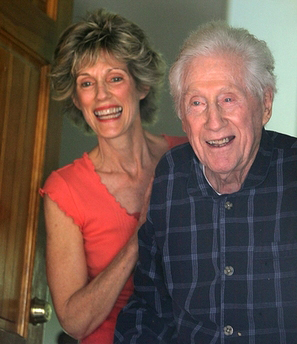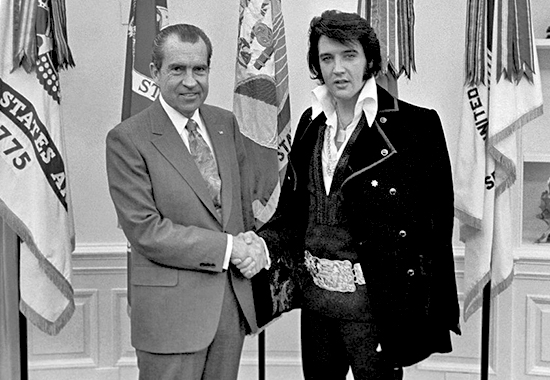|

Watergate Complex, Washington
The Watergate Scandal
The Watergate Scandal was discovered
during the term of
 President Nixon,
the 14th Republican president.
President Nixon,
the 14th Republican president.
|
|
Image Above
The Watergate
Complex in Washington in 1973
America.gov / AP Images |
What is
Watergate?
Watergate is a building in Washington DC where the Democratic
National Committee had their headquarters.
See photo above.
In
a Nutshell — What Happened?
In 1972, five men were arrested for breaking into the Watergate
building, for theft and wiretapping.

From left: James
McCord, Jr., Virgilio Gonzalez, Frank Sturgis, Eugenio Martinez, and
Bernard Barker
Investigations finally found
out that the break-in was ordered.
Additionally, various other crimes
were exposed, such as political espionage and corruption.
In the end, Nixon resigned and
 Gerald Ford
became the next president.
Gerald Ford
became the next president.

Nixon Resigns in Tears — 1974
Online Photograph. Encyclopædia Britannica.
Here is
 President Ford's
Pardon Speech for which he received a lot of
criticism.
President Ford's
Pardon Speech for which he received a lot of
criticism.
For more about Nixon's end of it,
and for a Watergate Timeline, go here:
 Richard Nixon and
Watergate
Richard Nixon and
Watergate
Who Were the
Plumbers?
"Plumbers" was the name for a White
House Special Investigations Unit established in 1971. The Unit was
under the direction of Egil "Bud" Krogh.
According to the Jimmy Carter Library, "The unit was to
investigate the leaks of top-secret government documents,
particularly the Pentagon Papers, to the press. The president
considered this task critical to national security. Nixon said he
wanted the unit headed up by a "real son of a bitch." He got the
studious, zealous, and loyal-to-a-fault Bud Krogh instead."
In newspaper accounts, on December 7, 1972,
Kathleen Chenow, a White House secretary, confirms the
existence of a "Plumbers Unit" in the White House as an internal
investigative unit.
She stated that its members were
David R. Young,
G. Gordon Liddy,
E. (Everette) Howard Hunt, and
Egil Krogh. She states that the
unit was investigating leaks to the news media.
On December 8, 1972, in Chicago,
Illinois, a United Airlines jet crashes killing Dorothy Hunt, the
wife of E. Howard Hunt. FBI agents at the scene recover $10,000 in
one hundred dollar bills found in the pocket book of Mrs. Hunt.
What gave?
According to the FBI Watergate
Summary, John D. Ehrlichman, the Chief Counsel to the President and
later Assistant to the President for Domestic Affairs, established
the in-house investigative unit officially titled "The White House
Special Investigations Unit," later to be known as the "Plumbers
Unit".
Ehrlichman is alleged to have approved
the office burglary of Dr. Fielding, the psychiatrist to Daniel
Ellsberg, which took place on September 3-4, 1971.
Ehrlichman resigned on April 30, 1973,
at the same time that the President fired John Dean and also
accepted the resignation of H.R. Haldeman.
Who Was Deep Throat?
Deep Throat was the alias for
W. Mark Felt, an FBI agent. He leaked
information to Washington Post reporters Bob Woodward and
Carl Bernstein.
Deep Throat's identity wasn't revealed until the
year 2005 when Vanity Fair magazine dropped the bomb in their July
issue.
W. Mark Felt was on Larry King Live
in 2006, talking for the first time publicly about Watergate.
Felt
died on December 18, 2008, at the age of 95.
This from Associated Press:

Joan Felt and and her father Mark Felt look towards the media
gathered in front of their home on May 31, 2005, in Santa Rosa,
Calif.
Mark Felt, 91, was second-in-command at the FBI in the early
1970s. Felt claims he was 'Deep Throat,' the long-anonymous source
who leaked secrets about President Nixon's Watergate cover-up to The
Washington Post, his family said.
(AP Photo/Ben Margot)
Watergate Scandal —
Trivia
The Watergate Scandal was made into a movie in
 All
the President's Men with Dustin Hoffman as Carl Bernstein
and Robert Redford as Bob Woodward.
All
the President's Men with Dustin Hoffman as Carl Bernstein
and Robert Redford as Bob Woodward.
Richard G.
Kleindienst, who was Nixon's attorney general for less
than a year in the Watergate era and who pleaded guilty, died on
February 4, 2000, of lung cancer, at his home in Prescott, Arizona.
He was 76.
According to the Gerald R. Ford
Museum, the character of Jim Phelps
in the television series Mission Impossible played by Peter
Graves was based on Everette Howard Hunt,
Jr.
E. Howard Hunt was a CIA operative who
took part in the 1954 coup in Guatemala and the 1961 Bay of Pigs
invasion of Cuba. Hunt also wrote spy novels.

Peter Graves is Jim
Phelps, a tribute to E. Howard Hunt, Jr.
Photo by Gene Trindl, ©1978
Gene Trindl, Image courtesy mptvimages.com
More Papers
The National Archives in Washington released a batch of over
10,000 pages of documents from the Nixon presidency.
What are
we looking at?
-
Mark Felt, aka Deep Throat, gets
excellent recommendations from various individuals and people are
urging President Nixon to make him the new FBI director. But Nixon
skips Felt and appoints L. Patrick Gray instead. Gray resigns a year
later because of allegations he had destroyed Watergate documents.
-
All kinds of things regarding the Middle
East
-
Memos about whether or not to support a Kurdish revolt in
Iraq
-
Young Dick Cheney's resume of the year 1969
-
Documents on
Elvis' visit with Nixon on December 21, 1970.
Those were the days.

Elvis invited himself to the White House, as
kings do, and, on December 21, 1970, he shook
Nixon's hand in the Oval Office
Update July 29, 2011:
This from Reuters:
Nixon's secret Watergate testimony ordered
released
More than 36
years later, the secret grand jury testimony
of President Richard Nixon in the Watergate
scandal was ordered released on Friday by a
federal judge because of its significance in
American history.
[...]
Nixon's grand
jury transcript will not be released
immediately because the government will have
the opportunity to appeal. A Justice
Department spokesman said government lawyers
were reviewing the ruling.
Here is the entire
 Reuters article.
Reuters article.
November 10, 2011
Update — Thanks to the historian
Stanley Kutler,
University of Wisconsin, who sued to obtain a closer look at the Nixon /
Watergate mess, the National Archives has
released more documents for us.
Included are
transcripts of President Nixon's grand jury
testimony of June 23-24, 1975, and associated
material. You can read everything online.
What's of special
interest?
Famous head
scratcher was the 18-1/2 minute gap on tapes of
Nixon's White House conversations. The
conversation was between Nixon and his chief of
staff, H.R. Haldeman,
after the break-in.
-
Did it include
incriminating information about the break-in
at Democratic National Headquarters by his
campaign operatives?
-
And did
Nixon's assistant,
Rose Mary Woods, erase the
conversation when she was transcribing the
tapes?
The content of the
conversation has never been revealed.
Nixon swore it was
an accident that tapes had been erased. "Rose had thought
it was four minutes ... and now the counsel have
found that it is eighteen and a half minutes,
and I practically blew my stack," Nixon told the
grand jury.
Yet, some portions
of the grand jury testimony are still classified
to safeguard national security or the privacy of
people who are still alive.
 Here is the link.
Here is the link.
"I hereby resign the Office of
President of the United States."
Richard M.
Nixon, August 9, 1974

Richard Nixon delivering the "V"
sign
upon his final departure
from
the White House, August 9, 1974
Photographer: Robert L. Knudsen, National Archives
Again, here is the link to the
 Watergate Timeline
Watergate Timeline
More History
|